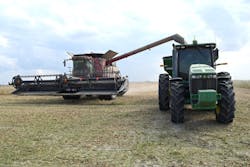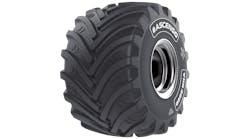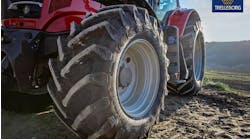Modern Tire Dealer has partnered with AG Tire Talk to provide answers to insightful questions that farm tire dealers have about farm tire technology. This is the next installment in our ongoing series, which is designed to help farm tire dealers better connect with their customers. A trending question, followed by answers, will appear in our Commercial Tire Dealer section every other month. For complete answers, click on www.agtiretalk.com. (You can access the latest episode of the AG Tire Talk podcast here.)
Question: Carbon dioxide is released in large quantities through tillage or plowing. No-till farming practices help keep carbon dioxide from being released. Reduced tillage also improves soil health. As the federal government pushes new environmental standards, farmers are now being paid to reduce tillage. How can tire technology and inflation management help?
Dave Paulk, manager, field technical services, BKT USA: In the carbon economy, farmers can be offered opportunities to sell carbon credits - thus generating more income - through conservation practices. Farmers can manage their soil to increase carbon stocks. Some of the ways are to minimize soil disturbance, maximize living roots and biodiversity and maximize soil cover.
When no-till practices are used, the soil must be protected from compaction. Compacting soil can affect water and fertilizer absorption, obstruct plant root growth and other things. Soil protection can be accomplished by running the correct air pressure on tractors and implements. Enough air must be used to carry the weight of equipment. But using too much air in tires can cause compaction and lead to reduced crop yields.
Using the correct tires for the application helps as the farmer can then spread the weight of his equipment over a larger area with correct air pressures. Radials can be run at lower air pressures for less ground-bearing pressure and decrease soil compaction. Increased flexion (IF) and very-high flexion (VF) technology can be used to lessen soil compaction as they can carry the same weight as a standard tire at lower pressure levels.
Harm-Hendrik Lange, customer solutions engineer, Continental Commercial Specialty Tires: A carbon-conscious farm will keep as much organic material bonded with the soil as possible. Carbon sequestration is not a x-all, however. Farmers are moving to more conservative work styles, like strip-till and no-till farming.
Strip-till is the minimal tilling of six to eight-inch strips that leaves the area between rows undisturbed. No-till farmers plant into previous crop areas.
All farm equipment is heavy. But as we have learned, soil compaction can be combated. Strip-till and no-till farming reduce the number of passes through a field, but the reduction becomes irrelevant without considering the impact of tires.
As a general rule, most high aspect ratio tires with high inflation pressure will leave a track of compaction. In contrast, most low aspect ratio tires with lower inflation pressures will increase the tire’s footprint. Therefore, selecting the right tires for your customer’s application is key to success.
Equipment running on worn tires requires extra gas to keep traction. Extra fuel means more emissions.
Rick Harris, region sales manager, Global Rubber Industries Pvt. Ltd.: The weight of agricultural machinery is inevitably increasing. This has a detrimental effect on productive agriculture. It is very important to recommend the right tires to maintain important soil properties.
To reduce soil compaction, farmers should use tires that cover a greater area or use several tires of the same type. Air pressure in a tire is important in gaining the ability to create a large contact area and hence a large footprint. This can be done using a standard tire with lower pressure or using a modern VF or IF tire.
The flotation ability of a tire creates the ability of a vehicle to almost oat on the ground, reducing the pressure put on soil.
Greg Gilland, vice president, global agriculture, Maxam Tire North America: The U.S. Geological Survey defines carbon sequestration as the process of capturing and storing atmospheric carbon dioxide. It is one method of reducing the amount of carbon dioxide in the atmosphere, with the goal of reducing global climate change.
Soils can either emit or absorb carbon dioxide. The turning of topsoil during plowing, planting or fertilization mixes underground carbon-containing molecules with atmospheric oxygen. The challenge for agriculture moving forward is how we mitigate or reduce the impact of carbon emissions in our day-to-day operations.
The practice of plowing or tillage after harvest is considered to be responsible for increased emission of gas from soil. If the right tire is used with a vehicle traveling a controlled path, farmers can avoid row overlaps - ensuring reduced soil damage, improving crop yields and reducing carbon emissions. A larger tire footprint will deliver improved performance and reduce ground pressure, which will result in the mitigation of carbon gas emissions.
David Graden, operational market manager, agriculture, Michelin North America Inc.: Agricultural carbon sequestration is coming at us like a freight train. It is inevitable that farmers will be strongly encouraged or even forced to comply with sequestration in the coming years. That’s why we must pay attention to carbon sequestration methodologies and the tires that play such a pivotal role.
When we talk about reducing disruption to soil, we mean preserving pockets of space where air and nutrients reside. In turn, plants grow much faster and healthier to produce higher yields. Additionally, less soil disruption means carbon gas remains trapped in those air pockets, providing additional nutrients for plants. Further, due to larger tire footprints, traction increases and fuel economy improves.
All indicators are telling us that carbon sequestration is here to stay. In fact, for those who are able to do so and move fast enough, there is a huge upside to helping your customers prepare for the future.
Blaine Cox, national product manager, agriculture, golf and turf, Yokohama Off-Highway Tires America Inc.: Carbon sequestration is very important to American farmers because carbon is the key ingredient in soil organic matter and because sequestering carbon is emerging as a potential revenue stream for them.
This is the time for farmers to position themselves to take advantage of future opportunities and be ready to stay ahead of possible regulations.
There are two important issues when it comes to tires and carbon management. First, a large footprint and the lowest appropriate inflation pressure for the machine’s load and speed are necessary for reducing soil compaction. The second is resistance to damage from crop residue in no-till and reduced-till fields. Stalk stompers and other mechanical means to push down residue really help, but tires need to be able to withstand a lot of abuse, especially with today’s extra-stiff stalks.



